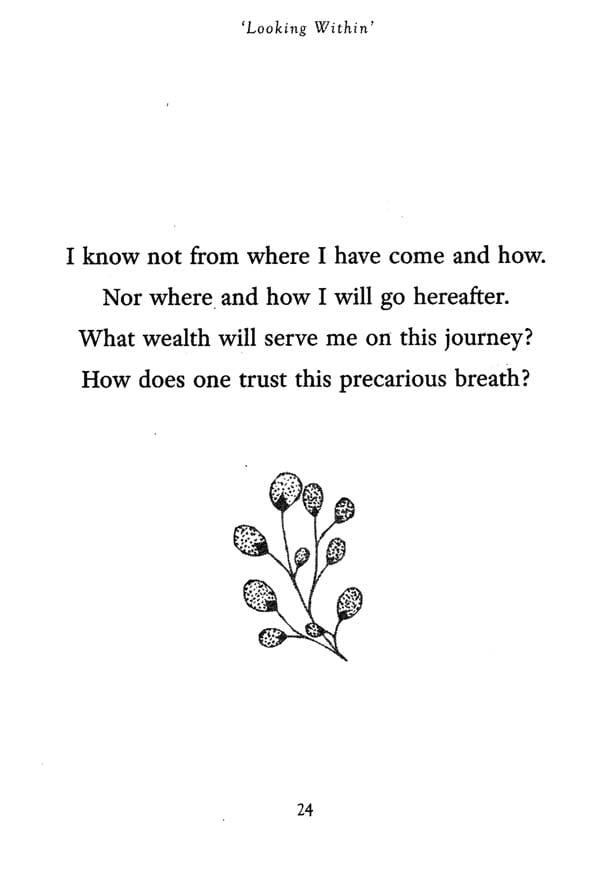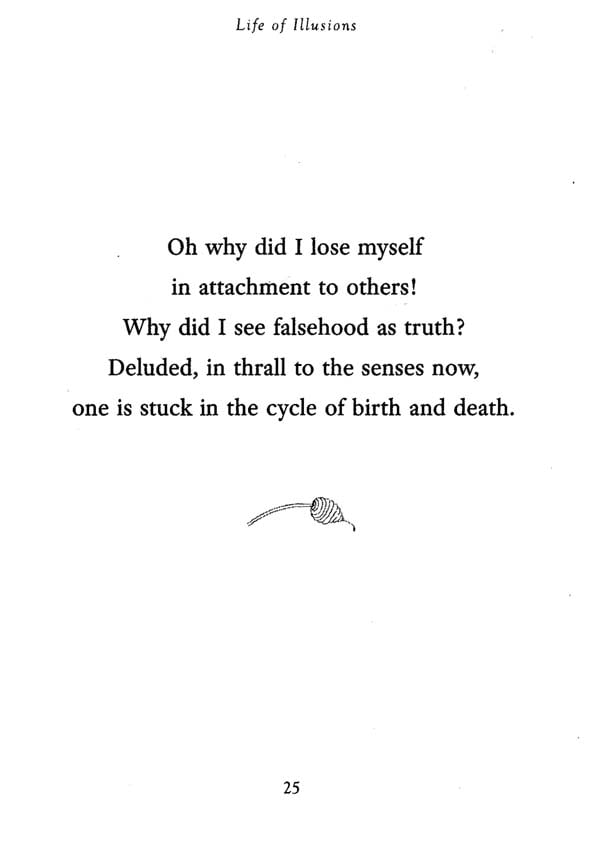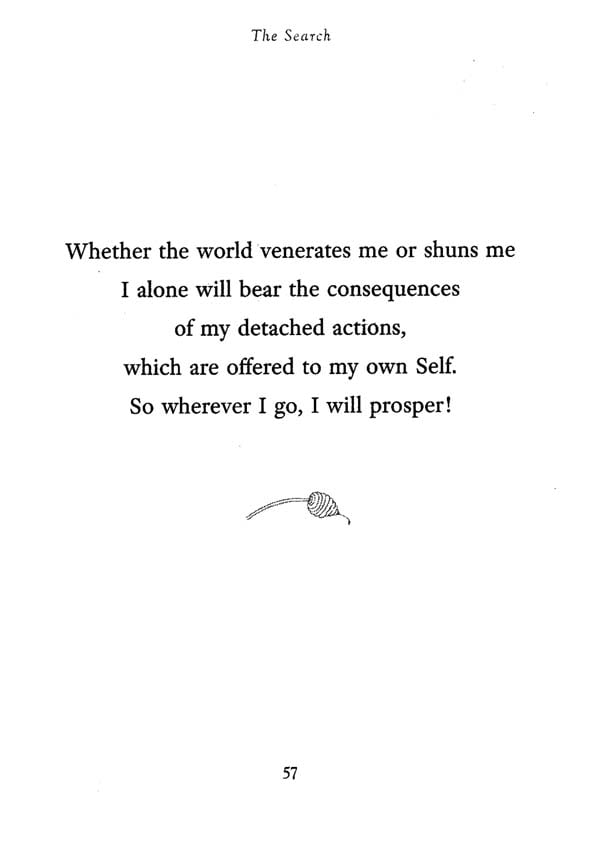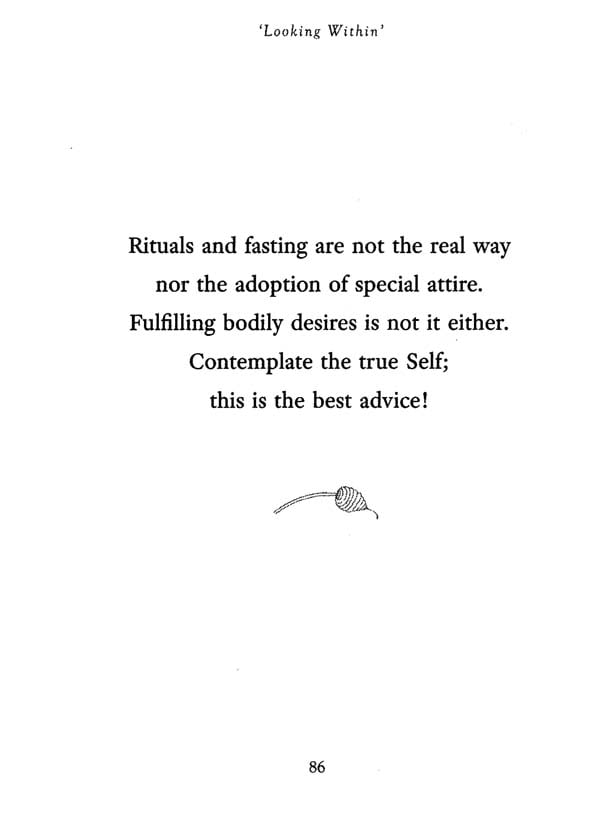
'Looking Within'- Life Lessons From Lal Ded
Book Specification
| Item Code: | NAX239 |
| Author: | Shonaleeka Kaul |
| Publisher: | Aleph Book Company |
| Language: | English |
| Edition: | 2019 |
| ISBN: | 9789388292702 |
| Pages: | 124 |
| Cover: | HARDCOVER |
| Other Details | 7.50 X 5.00 inch |
| Weight | 170 gm |
Book Description
India has produced some of the world's greatest religious leaders, sages, saints, philosophersand spiritual thinkers. They were monks, nuns and renunciates, nationalists and reformers.No one religion had a monopoly on them. They range from Mahavira and Buddha, who livedover 2,500 years ago, to medieval saints like Chishti, Avvaiyar and Guru Nanak, to morerecent philosophers and religious icons such as Vivekananda, Ramakrishna, Saint Teresaand many others. The spiritual and philosophical heritage they left behind is India's gift toall Indians and the world.In the 'Life Lessons' series we publish the essential teachings of some of India's best-knownspiritual teachers, along with commentaries and biographical notes. Each book will be ahandy companion to help the reader along the difficult pathways of life. *Lal Ded (Granny Lal), as Lalleshwari was known, was a Shaiva mystic saint who lived inKashmir, probably in the fourteenth century. Born into a Brahmin family of Pandrethan (nearSrinagar), she is said to have had an early bad marriage and faced many domestic hardships,prompting a turn to spirituality. She renounced her marriage and material life and becamea wandering mystic. She shared her wisdom in the form of vaakhs (sayings or utterances).These vaakhs (originally in the Kashmiri language) have seeped far and wide into popularusage and are part of the collective memory-through songs, proverbs and hymns-ofKashmiris of all stripes, through the generations. In these vaakhs, Lal Ded talked about thewoes of the human condition, her disillusionment with the world, her anguished search forGod, and, ultimately, her realization of God as pure consciousness. She rejected outwardrituals, ostentation and extreme asceticism as paths to reach the truth. Her observations onthe transience and futility of material pursuits and the emotions they generate, like greed,anger, pride and fear, apply to us all. While her sayings are deeply profound, her humanismmakes it easy to relate to Lal and her teachings.Translated and edited by Shonaleeka Kaul, the aphorisms in 'Looking Within' represent LalDed's core teachings.
Shonaleeka Kaul is a cultural historian of early South Asia, specializing inworking with Sanskrit texts. She is associate professor in the Centre for HistoricalStudies, Jawaharlal Nehru University, and currently visiting professor at the SouthAsia Institute, Heidelberg University, Germany. She was also the Malathy SinghDistinguished Lecturer in South Asian Studies at Yale University, USA, and the JanGonda Fellow in Indology at Leiden University, The Netherlands. She is the authorof The Making of Early Kashmir: Landscape and Identity in the Rajatarangini, amongother books.
Who was Lal Ded?* Fittingly for someone who espoused the insignificance of worldly identities, little is known about this Shaiva mystic saint except that she lived in Kashmir, probably in the fourteenth century. Her relative anonymity notwithstanding, perhaps there isn't a single Kashmiri who has not heard of Lal Ded (Granny Lal) or Lal Maej (Mother Lal), whose full name was Lalleshwari, or of her many sayings that have seeped far and wide into popular usage. Such was the love and respect in which she was held by the masses in Kashmir that much later texts in Persian, like the Tazkirat ul Arifin and the Tarikh I Azami, written by Muslim scholars between the sixteenth and eighteenth centuries, were also impelled to mention her. In fact, her near-contemporary, the Islamic Sufi saint Sheikh Nooruddin or Nund Rishi, as he came to be known, was deeply influenced by Lal's teachings and the order he founded came to be known as the Rishi-Sufi order, representing the syncretism for which Kashmir was once famous. It is worth noting, however, that Lal Ded herself did not found any movement or order of followers; she came and went alone, a wanderer-her message meant for the redemption of the individual soul.
The texts mentioned above provide us with some legendary biographical details about Lal, such as her birth in a Brahmin family of Pandrethan (near Srinagar), an early, bad marriage and many domestic hardships faced in her marital home, prompting a turn to spirituality. She is said to have been guided in this by a guru, Siddha Srikantha or Siddhamol (Enlightened Father). However, there is no way to know if all (or any) of this is true, for Lal's own verses in the Kashmiri tongue, known as vaakhs (literally 'sayings' or 'utterances', from the Sanskrit vaak), do not provide any such information. They do, however, refer to her guru. In any case, as scholars have pointed out, the greatness of Lal is hardly limited to her life story, as we shall see.
Though not speaking specifically about her own life, Lal's vaakhs are deeply personal. In these vaakhs, she uses the first person and also names herself frequently, using her shorter, pet name. For example, the phrase 'I, Lal' or even `Lalli' is a common refrain in the vaakhs, prefacing her sayings in a conversational style-where the conversation is often with herself. Seen in other mystics as well, talking to herself in her vaakhs is a technique that points to Lal Ded's central teaching of turning inwards to arrive at life's greatest truths. Thus she says:
**Contents and Sample Pages**











